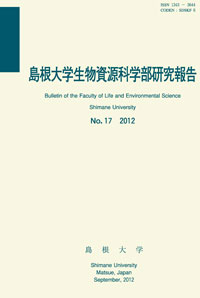島根大学生物資源科学部
ISSN:2435-0885(オンライン)
ISSN:1343-3644(冊子体)
なお、冊子体の刊行は23巻まで
ISSN:1343-3644(冊子体)
なお、冊子体の刊行は23巻まで

ダウンロード数 : ? 件
この文献の参照には次のURLをご利用ください : https://ir.lib.shimane-u.ac.jp/5109
島根大学生物資源科学部研究報告 8
2003-12-20 発行
硬骨魚類における幽門垂の比較組織学的研究 : 幽門垂の解剖学および組織学的構築と系統発生学的相関
Comparative Histological Study of Pyloric Ceca in Teleosts : Anatomical and Histological Structures Associated with Their Phylogeny
ファイル
内容記述(抄録等)
Background/aims: Teleosts have blind tubes, so called pyloric cecum, connected with the anterior end of the small intestine. These pyloric ceca vary in number between1and more than 1000. However, the function of the pyloric ceca is not clear. Since they originate from that region of the intestine where bile and pancreatic juices are released, the ceca many form digestive compartments active in resorption of certain nutrients. We studied on the correlation between the histological components in pyloric ceca and their phylogeny by histological technique. Methods: Forty-six species teleosts that lived in fresh-water, brackish-water and sea, were collected from Shimane and Iriomote in Okinawa. Pyloric ceca were fixed with paraformaldehyde, and observed by light microscopy. Results: The pyloric ceca closely resembled the small intestine in structure, with a well-developed muscularis consisting mainly for circular muscle fibers. Mucus secreting goblet cells occurred among the epithelial cells. Conclusions: The present study indicates that the structures of pyloric ceca is concerned with phylogenetic classification. Our findings demonstrate that pyloric ceca may play a role in the duodenum.
About This Article
Other Article
PP. 23 - 27
